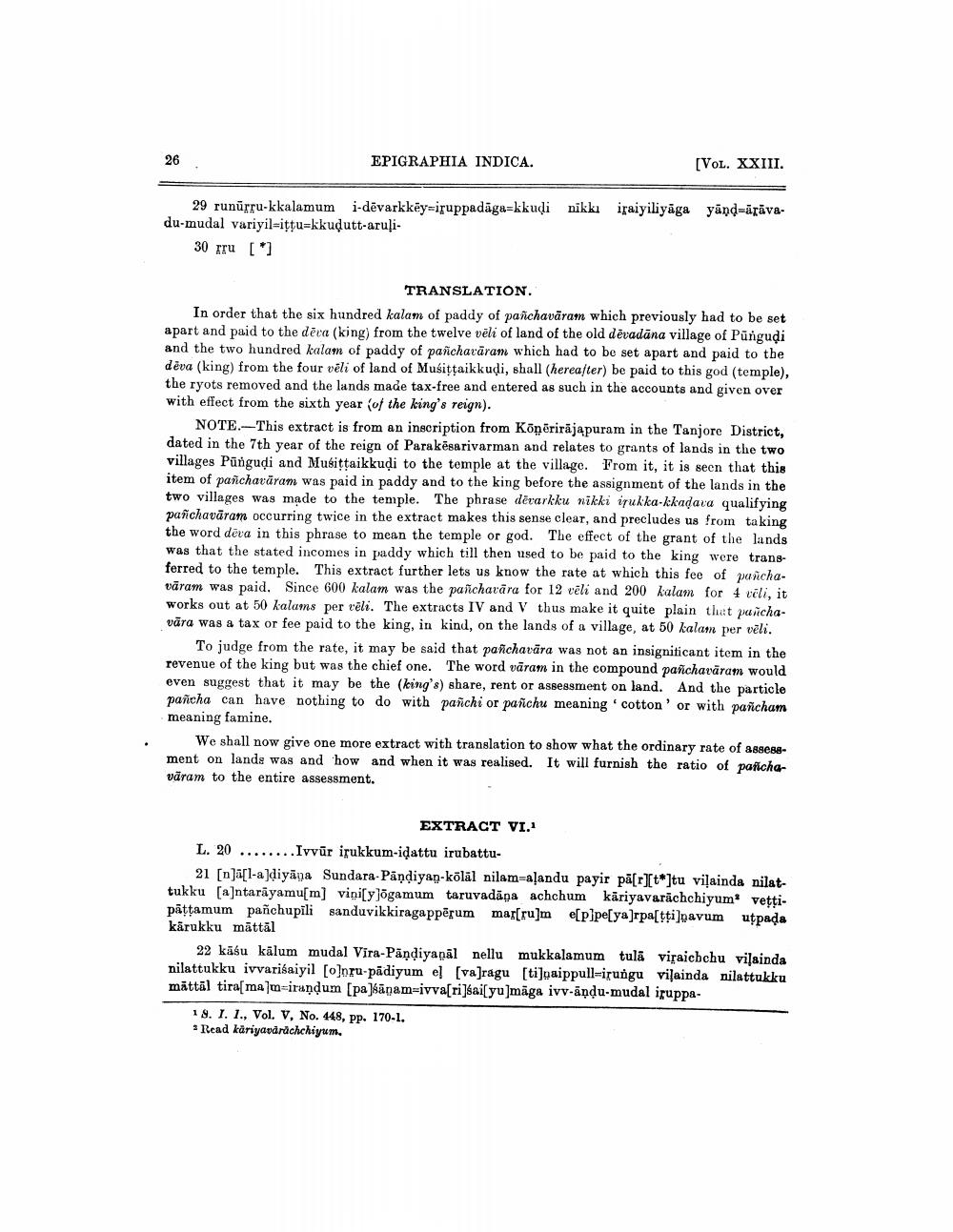________________
26.
EPIGRAPHIA INDICA.
[Vol. XXIII.
nikkı
iraiyiliyāga
yand-agāva
29 runūrru-kkalamum i-dēvarkkėy-iruppadaga=kkudi du-mudal variyil-ittu=kkudutt-aruļi
30 tru []
TRANSLATION In order that the six hundred kalam of paddy of panchavāram which previously had to be set apart and paid to the dēva (king) from the twelve vēli of land of the old dēvadāna village of Punguļi and the two hundred kalam of paddy of pañcharāran which had to be set apart and paid to the dēva (king) from the four vēli of land of Musitaikkudi, shall (hereafter) be paid to this god (temple), the ryots removed and the lands made tax-free and entered as such in the accounts and given over with effect from the sixth year of the king's reign).
NOTE.-This extract is from an inscription from Kõņērirājąpuram in the Tanjore District, dated in the 7th year of the reign of Parakesarivarman and relates to grants of lands in the two villages Pungudi and Musittaikkudi to the temple at the village. From it, it is seen that this item of pañchavāram was paid in paddy and to the king before the assignment of the lands in the two villages was made to the temple. The phrase dēvarkku Nikki irukka-kkadava qualifying panchavāram occurring twice in the extract makes this sense clear, and precludes us from taking the word diva in this phrase to mean the temple or god. The effect of the grant of the lands was that the stated incomes in paddy which till then used to be paid to the king were transferred to the temple. This extract further lets us know the rate at which this fee of pañchavāram was paid. Since 600 kalam was the pañchavāra for 12 vēli and 200 kalam for 4 véli, it works out at 50 kalams per vēli. The extracts IV and V thus make it quite plain that panchavāra was a tax or fee paid to the king, in kind, on the lands of a village, at 50 kalam per vēli.
To judge from the rate, it may be said that pañchavāra was not an insigniticant item in the revenue of the king but was the chief one. The word vāram in the compound pañchavāram would even suggest that it may be the king's) share, rent or assessment on land. And the particle pancha can have nothing to do with pañchi or pañchu meaningcotton' or with pancham meaning famine.
We shall now give one more extract with translation to show what the ordinary rate of 888088ment on lands was and how and when it was realised. It will furnish the ratio of pafichavāram to the entire assessment.
EXTRACT VI. L. 20 ........ Ivvār irukkum-idattu irubattu
21 [n]a[l-a]diyāna Sundara-Pāņdiyan-kõlal nilam=aļandu payir pā[1][t*]tu viļainda nilattukku [a]ntarāyamu[m] vinisylogamum taruvadāpa achchum kāriyavarachchiyum' vettipāttamum pañchupili sanduvikkiragappērum mar[ru]m [p]pe[ya]rpa[ttipavum utpada kärukku mättal
22 kāśu kälum mudal Vira-Pāņdiyanāl nellu mukkalamum tulā viraichchu vilainda nilattukku ivvarilaiyil [o]oru-padiyum el [va]ragu [tilgaippull-irungu visainda nilattukku mättāl tira[malm=irandum (pasāŋam=ivva[ri]šaisyu]mäga ivv-andu-mudal iruppa
19. I. 1., Vol. V, No. 448, pp. 170-1. - Rcad kariyardůchchiyum.




